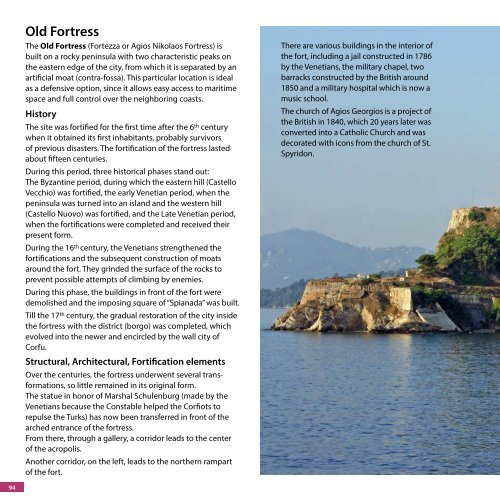You also want an ePaper? Increase the reach of your titles
YUMPU automatically turns print PDFs into web optimized ePapers that Google loves.
Old Fortress<br />
The Old Fortress (Fortezza or Agios Nikolaos Fortress) is<br />
built on a rocky peninsula with two characteristic peaks on<br />
the eastern edge of the city, from which it is separated by an<br />
artificial moat (contra-fossa). This particular location is ideal<br />
as a defensive option, since it allows easy access to maritime<br />
space and full control over the neighboring coasts.<br />
History<br />
The site was fortified for the first time after the 6 th century<br />
when it obtained its first inhabitants, probably survivors<br />
of previous disasters. The fortification of the fortress lasted<br />
about fifteen centuries.<br />
During this period, three historical phases stand out:<br />
The Byzantine period, during which the eastern hill (Castello<br />
Vecchio) was fortified, the early Venetian period, when the<br />
peninsula was turned into an island and the western hill<br />
(Castello Nuovo) was fortified, and the Late Venetian period,<br />
when the fortifications were completed and received their<br />
present form.<br />
During the 16 th century, the Venetians strengthened the<br />
fortifications and the subsequent construction of moats<br />
around the fort. They grinded the surface of the rocks to<br />
prevent possible attempts of climbing by enemies.<br />
During this phase, the buildings in front of the fort were<br />
demolished and the imposing square of “Spianada” was built.<br />
Till the 17 th century, the gradual restoration of the city inside<br />
the fortress with the district (borgo) was completed, which<br />
evolved into the newer and encircled by the wall city of<br />
Corfu.<br />
Structural, Architectural, Fortification elements<br />
Over the centuries, the fortress underwent several transformations,<br />
so little remained in its original form.<br />
The statue in honor of Marshal Schulenburg (made by the<br />
Venetians because the Constable helped the Corfiots to<br />
repulse the Turks) has now been transferred in front of the<br />
arched entrance of the fortress.<br />
From there, through a gallery, a corridor leads to the center<br />
of the acropolis.<br />
Another corridor, on the left, leads to the northern rampart<br />
of the fort.<br />
There are various buildings in the interior of<br />
the fort, including a jail constructed in 1786<br />
by the Venetians, the military chapel, two<br />
barracks constructed by the British around<br />
1850 and a military hospital which is now a<br />
music school.<br />
The church of Agios Georgios is a project of<br />
the British in 1840, which 20 years later was<br />
converted into a Catholic Church and was<br />
decorated with icons from the church of St.<br />
Spyridon.<br />
94



